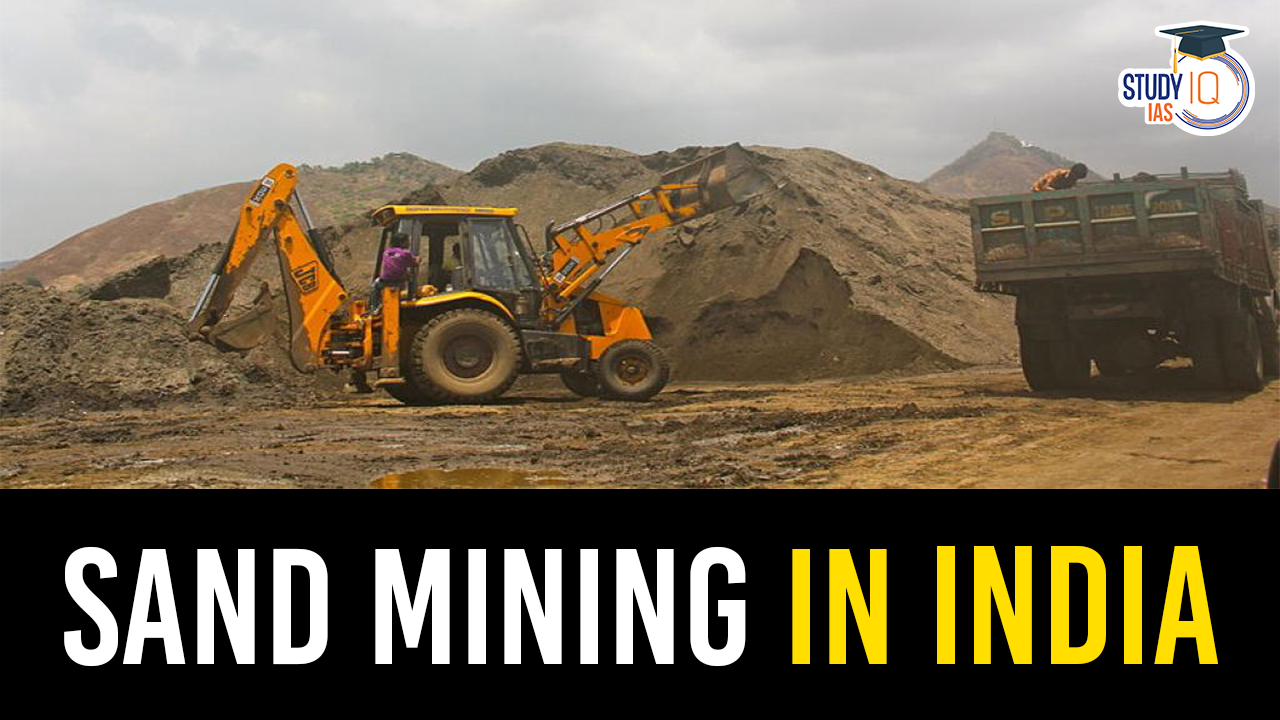Table of Contents
Sand, a seemingly abundant resource, is the second most consumed natural resource on the planet after fresh water. In India, the demand for sand has surged exponentially in recent years due to rapid urbanization, infrastructure development, and a booming construction industry. However, the unregulated and rampant exploitation of this invaluable resource has given rise to a critical environmental issue – illegal sand mining.
We’re now on WhatsApp. Click to Join
Illegal Sand Mining
Illegal sand mining in India is a crime under Sections 378 and 379 of the Penal Code, 1860. This is because natural resources are public property, and the state is its trustee.
Illegal sand mining can have negative social and economic impacts on local communities. It can lead to the displacement of communities that depend on riverbanks for their livelihoods, such as fishing and agriculture.
Illegal and excessive sand mining can also result in environmental degradation. For example, illegal sand mining in the Papagani catchment area in Karnataka has resulted in groundwater depletion and environmental degradation in communities along the river’s banks in both Andhra Pradesh and Karnataka.
The Mines and Minerals (Development and Regulation) Act, 1957 (MMDR Act) empowers state governments to make rules for regulating the grant of mineral concessions in respect of minor minerals.
Causes of Illegal Sand Mining
High Demand for Construction
The construction industry’s insatiable appetite for sand, a key ingredient in concrete, is a primary driver of illegal sand mining. As cities expand and infrastructure projects multiply, the demand for sand skyrockets, leading to illegal extraction from riverbeds, beaches, and other ecologically sensitive areas.
Lax Regulatory Framework
Weak regulatory measures and ineffective enforcement have created an environment conducive to illicit sand mining. The absence of stringent laws and their lax implementation contribute to the proliferation of illegal activities, allowing perpetrators to operate with impunity.
Lack of Alternative Materials
The lack of viable alternatives to sand in construction exacerbates the problem. While there are efforts to develop substitutes, such as recycled materials, their widespread adoption is hindered by cost considerations and technological challenges.
Effects of Illegal Sand Mining in India
Environmental Degradation
Unregulated sand mining leads to the destruction of river ecosystems and coastal habitats. The removal of sand alters river channels, disrupts sediment balance, and contributes to erosion. The loss of vegetation along riverbanks further exacerbates environmental degradation.
Impact on Biodiversity
Sand mining negatively impacts aquatic and terrestrial ecosystems, jeopardizing the biodiversity of flora and fauna. Disruption of riverbeds and sediment transport affects fish habitats, leading to a decline in fish populations. Additionally, the disturbance of nesting grounds for various species of turtles and birds poses a threat to their survival.
Groundwater Depletion
Excessive sand mining can alter the natural flow of rivers, affecting groundwater recharge. This, in turn, contributes to the depletion of groundwater resources, which are crucial for sustaining agriculture and providing drinking water to communities.
Social Consequences
The social ramifications of illegal sand mining are significant. Conflicts often arise between local communities dependent on rivers for their livelihoods and sand miners. The illegal nature of the activity further exacerbates these tensions, leading to disputes over resource access.
Constitutional and Legal Framework
The legal foundation for regulating the mining sector in India is established through the Mines and Minerals (Development and Regulation) (MMDR) Act of 1957. The constitutional division between the state and central governments, as specified in Lists I and II, mandates their respective roles in mineral ownership and governance.
The MMDR Act empowers state governments to manage minor minerals, including sand, while requiring central approval for major minerals such as coal and rare earths. This dual governance framework ensures a balance between centralized control and regional autonomy, crucial for effective and sustainable management of India’s mineral wealth.
Sustainable Sand Mining Management Guidelines 2016
The Sustainable Sand Mining Management Guidelines 2016 were released by the Union Ministry of Environment and Forests. The guidelines aim to ensure that sand and gravel mining is environmentally and socially responsible.
Main Goals
- Environmental and Social Responsibility:
-
- Ensure sand and gravel mining is conducted in an environmentally sustainable and socially responsible manner.
- Sustainable Aggregate Availability:
-
- Guarantee an adequate quantity of aggregate is available sustainably, preventing over-exploitation.
- Enhanced Mining Monitoring and Transportation:
-
- Improve the efficiency of mining monitoring and the transportation of mined-out material.
- River Conservation and Equilibrium:
-
- Conserve the river’s equilibrium and natural environment by protecting and restoring the ecological system.
- Prevent Downstream Aggradation:
-
- Avoid aggradation in downstream areas, especially those housing hydraulic structures like jetties and water intakes.
- Protection from Bank and Bed Erosion:
-
- Ensure rivers are safeguarded from bank and bed erosion beyond their stable profile.
- Unobstructed River Flow and Water Transport:
-
- Prevent obstruction to river flow and water transport, while restoring riparian rights and in-stream habitats.
- Prevent Water Pollution:
-
- Avoid pollution of river water to prevent deterioration of water quality.
- Prevent Groundwater Depletion:
-
- Mitigate excessive groundwater draining to prevent depletion of groundwater reserves.
- Streamlined Environmental Clearance Process:
-
- Streamline the environmental clearance (EC) process for sustainable mining, facilitating responsible extraction practices.
The guidelines require the preparation of District Survey Reports (DSRs) before granting mining leases. The guidelines also state that the layers of sand and gravel that can be removed from the river bed depend on the river’s width and replenishment rate. The guidelines also prohibit the extraction of sand and gravel where erosion may occur, such as at the concave bank.
Sand is mainly used for concrete, which is in high demand due to urbanization. Sand can also be used as a mixer with salt to prevent ice on roads, or to reshape coastlines that have significantly eroded.
Sand Mining in India UPSC
Illegal sand mining in India, governed by Sections 378 and 379 of the Penal Code, poses severe environmental and social consequences. Fueled by the construction industry’s voracious demand and a lax regulatory framework, it leads to river ecosystem destruction, biodiversity loss, groundwater depletion, and social conflicts. The Mines and Minerals (Development and Regulation) Act of 1957 divides governance between state and central governments. The Sustainable Sand Mining Management Guidelines 2016 aim to ensure responsible mining, emphasizing environmental conservation, efficient monitoring, and prevention of downstream aggradation. However, challenges persist, requiring a delicate balance between economic development and sustainable resource management.


 De-extinction of Dire Wolf: Is the Once-...
De-extinction of Dire Wolf: Is the Once-...
 Flue Gas Desulphurisation (FGD), Advanta...
Flue Gas Desulphurisation (FGD), Advanta...
 World Creativity and Innovation Day 2025...
World Creativity and Innovation Day 2025...






















